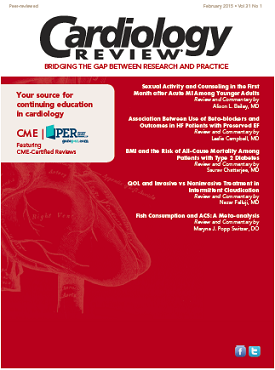Publication
Article
Cardiology Review® Online
Multivessel Vs. Culprit-Vessel-Only PCI In Patients with Acute Myocardial Infarction
In this edition of Clinical Forum, we asked three Cardiology Review editorial board members to comment on multivessel versus culprit-vessel-only PCI in patients with acute myocardial infarction, considering perspectives from the PRAMI and CvLPRIT trials.
In this edition of Clinical Forum, we asked three Cardiology Review editorial board members to comment on multivessel versus culprit-vessel-only PCI in patients with acute myocardial infarction, considering perspectives from the PRAMI and CvLPRIT trials.
Please send your comments or suggestions for future Cardiology Review Clinical Forum questions to Dr. Mukherjee at debabrata.mukherjee@ttuhsc.edu. Space permitting, we will post them online and in the iPad edition of the next issue.
Q. Has the time arrived for PCI of the non-infarct-related artery in STEMI patients?

Eric R. Bates, MD
Division of Cardiovascular DiseasesDepartment of Internal MedicineUniversity of Michigan Medical CenterAnn Arbor, MI
A:
At least 50% of patients with ST-elevation myocardial infarction (STEMI) have multivessel (MV) coronary artery disease. Thei rshort-term prognosis is worse than patients with single-vessel disease,1 perhaps due to additional plaque vulnerability,2 impaired myocardial perfusion,3 or decreased contractility.4 Percutaneous coronary intervention (PCI) options include: (1) culprit-only primary PCI with continued medical management and PCI of nonculprit arteries only for spontaneous or stress-induced myocardial ischemia; (2) MV PCI at the time of primary PCI; or (3) culprit-only primary PCI followed by staged PCI of nonculprit arteries later during the index hospitalization or soon after hospital discharge.
Clinical guidelines have recommended that primary PCI should not be performed in a nonculprit artery in patients who are hemodynamically stable. This recommendation was based on safety concerns that included an increased risk for procedural complications, contrast nephropathy, and stent thrombosis. However, advances in stent technology and antiplatelet therapy have improved procedural safety, and more complete acute revascularization might decrease mortality, reinfarction, and repeat revascularization rates and reduce resource utilization and cost.
Observational studies have reported conflicting results, with some demonstrating better,5 similar,6 or worse7outcomes with MV PCI compared with culprit-only primary PCI. The discordance may be due to differing inclusion criteria, patient factors,PCI technique and timing, and primary endpoints.
Randomized trials have reported lower mortality, reinfarction, and repeat revascularization rates with MV PCI. In the PRAMI (Preventive Angioplasty in Acute Myocardial Infarction) trial,8 with a mean follow-up of 23 months, the composite primary outcome of cardiac death, nonfatal MI, or refractory angina occurred in 21 (9%) patients treated with MV primary PCI compared with 53 (22%) patients treated with culprit-only primary PCI (hazard ratio [HR], 0.35; 95% confidence interval [CI], 0.21-0.58; P<.001). In the CvLPRIT (Complete Versus Culprit-Lesion Only Primary PCI) trial,9 the composite primary outcome of death, reinfarction, heart failure, and ischemia-driven revascularization at 12 months occurred in 15 (10%) patients with MV PCI compared with 31 (21%) patients with culprit-only primary PCI (HR, 0.49; 95% CI, 0.24-0.84; P=.009).
The large benefit with MV PCI in PRAMI and CvLPRIT most likely overestimates any true benefit because the trials were underpowered and few endpoints occurred. Further complicating interpretation of the numerous studies comparing culprit-only versus MV PCI is the fact that no data are available from most studies regarding patient or lesion selection criteria.
Studies that have compared outcomes following MV primary PCI with staged PCI of nonculprit lesions have favored staged PCI.10 Again, these studies are limited by selection bias and confounding, as well as by survival bias.
Therefore, until more definitive studies are available, physicians should evaluate both clinical data and lesion complexity to determine the optimal strategy for PCI in a patient with MV coronary artery disease and STEMI. Although MV PCI is feasible and probably safe in selected patients, routine MV PCI of intermediate or complex stenoses at time of primary PCI should not yet be encouraged. Demonstration of myocardial ischemia, multidisciplinary evaluation by the heart team, and staged PCI (or coronary artery bypass graft surgery) following appropriate use criteria is a more logical approach to pursuing complete revascularization in patients with multivessel disease.
References
1. Sorajja P, Gersh BJ, Cox DA, et al. Impact of multivessel disease on reperfusion success and clinical outcomes in patients undergoing primary percutaneous coronary intervention for acute myocardial infarction. Eur Heart J. 2007;28:1709-1716.
2. Goldstein JA, Demetriou D, GrinesCL, et al. Multiple complex coronary plaques in patients with acute myocardial infarction. N Engl J Med. 2000;343:915-922.
3. Gibson CM, Ryan KA, Murphy SA, et al. Impaired coronary blood flow in nonculprit arteries in the setting of acute myocardial infarction. J Am Coll Cardiol.1999;34:974-982.
4. Grines CL, Topol EJ, Califf RM, et al. Prognostic implications and predictors of enhanced regional wall motion of the noninfarct zone after thrombolysis and angioplasty therapy of acute myocardial infarction. Circulation. 1989;80:245-253.
5. Kong JA, Chou ET, Minutello RM,et al. Safety of single versus multi-vessel angioplasty for patients with acute myocardial infarction and multi-vessel coronary artery disease: report from the New York State Angioplasty Registry. Coron Artery Dis. 2006;17:71-75.
6. Jo HS, Park JS, Sohn JW, et al. Culprit-lesion-only versus multivessel revascularization using drug-eluting stents in patients with ST-segment elevation myocardial infarction: a Korean Acute Myocardial Infarction Registry-based analysis. Korean Circ J. 2011;41:718-725.
7. Iqbal MB, Ilsley C, Kabir T, et al. Culprit vessel versus multivessel intervention at the time of primary percutaneous coronary intervention in patients with ST-segment-elevation myocardial infarction and multivessel disease: real-world analysis of 3984 patients in London.CircCardiovascQual Outcomes. 2014;7:936-943.
8. Wald DS, Morris JK, Wald NJ, et al. Randomized trial of preventive angioplasty in myocardial infarction. N Engl J Med. 2013;369:1115-1123.
9. Gershlick AH. Complete versus Lesion only Primary-PCI Trial (CvLPRIT): treat the infarct-related artery only or all lesions? Presented at the European Society of Cardiology Congress, September 1, 2014; Barcelona, Spain.
10. Hannan EL, Samadashvili Z, Walford G, et al. Culprit vessel percutaneous coronary intervention versus multivessel and staged percutaneous coronary intervention for ST-segment elevation myocardial infarction patients with multivessel disease. JACC CardiovascInterv. 2010;3:22-31.

Pareena Bilkoo, MD, FACCDirector, Cardiac Catheterization LaboratoryEast Georgia Regional Medical CenterStatesboro, GA
A:
In patients who present with STEMI, 40% to 65% are found to have significant (>50%) coronary artery disease (CAD) in a vessel other than the culprit vessel during index coronary angiography and PCI.1 The 2013 American College of Cardiology (ACCF/AHA) STEMI guidelines recommend PCI of a non-infarct-related artery (non-IRA) at a time separate from the index PCI if there is spontaneous ischemia (class I), and is reasonable if there are intermediate- to high-risk characteristics on noninvasive testing (class IIa). PCI of a non-IRA at the time of primary PCI is currently considered harmful (class III).2 The 2014 European Society of Cardiology (ESC) guidelines on myocardial revascularization endorse the utility of multivessel PCI at the time of STEMI in patients with cardiogenic shock in the presence of multiple, critical, or unstable lesions or if ischemia continues despite treatment of the culprit lesion.3
Recently, the PRAMI and CvLPRIT trials have had cardiologists rethinking the current STEMI guidelines. PRAMI randomized approximately 460 patients into 2 groups, treatment of IRA alone versus both IRA and non-IRA (preventive PCI) during STEMI. Non-infarct arteries were treated if the stenosis was >50%. PRAMI was terminated early due to a significant difference in the primary outcome—a composite of cardiac death, nonfatal MI, or refractory angina in the preventive group (9% vs 23%; HR, 0.35; 95% CI, 0.21-0.58) over a mean follow-up of 23 months.4
CvLPRIT randomized 146 patients to treatment of IRA only and 150 patients to treatment of all significant (>70%) lesions. Major adverse cardiac events (MACE) occurred in 21.2% of the IRA- only group and 10% in the complete PCI group (P=.009) at 12 months. The complete PCI group demonstrated lower all-cause mortality, recurrent MI, heart failure, and repeat PCI rates, though significance was not reached.5 Similarly to PRAMI, a significant difference between the 2 groups was noted early, within 30 days.
Critics of the above-mentioned studies believe the early termination of PRAMI may overestimate the actual benefit found. Also, treatment of non-IRA lesions of 50% diameter does not occur in real-world patients. Both studies had a small sample size and event rates were low overall.
In 2014 a meta-analysis consisting of 3 randomized trials determining the benefit of preventive PCI in STEMI patients was performed, and included 748 patients with multivessel CAD and STEMI.6 The preventive PCI group showed significantly lower risk of cardiovascular deaths (pooled odds ratio [OR], 0.39; 95% CI, 0.18-0.83, P = .01), repeat PCI (pooled OR, 0.28; 95% CI, 0.18-0.44; P = .00001) and non-fatal MI (pooled OR, 0.38; 95% CI, 0.20-0.75; P = .005) when compared with the culprit vessel PCI group.
For real-world interventional cardiologists, assessment and planning of non-IRA lesions during STEMI can be complex. The choices are: (1) PCI of IRA and all significant non-IRA lesions at same setting, (2) in a setting of cardiogenic shock or ongoing angina, PCI of all significant lesions, (3) PCI of significant non-IRA lesions prior to discharge, (4) PCI of lesions based on further invasive evaluation (eg, fractional flow reserve or intravascular ultrasound), (5) PCI of significant non-IRA within a few weeks, and (6) optimum medical therapy for several weeks, with PCI of significant non-IRA if the patient has ongoing angina or a positive stress test. Other considerations in this decision are the possibility of coronary artery bypass or valve surgery in the near future, the contrast/radiation load, or a non-IRA critical stenosis that supplies a large area of myocardium.
The true definition of a “significant” lesion needs further clarification. The PRAMI trial defined significant lesions as >50% and CvLPRIT as >70%. In stable CAD, we currently do not perform PCI on 50% lesions. Also, during a STEMI, catecholamine levels are high, possibly exaggerating the severity of a non-IRA stenosis. Thus the timing of non-IRA PCI requires further study. I specifically prefer non-IRA PCI prior to discharge unless hemodynamic compromise is present. However, I believe it would be very helpful to see the results of a large, randomized trial evaluating IRA only versus IRA and non-IRA PCI and timing of the non-IRA PCI, with a mean follow-up of several years and assessment of hard end points so that we can redefine our approach if necessary and create new guidelines for the 40% to 65% of patients who present with multi-vessel CAD and STEMI.
References
1. Vlaar PJ, Mahmoud KD, Holmes DR Jr, et al. Culprit vessel only versus multivessel and staged percutaneous coronary intervention for multivessel disease in patients presenting with ST-segment elevation myocardial infarction: a pairwise and network meta-analysis. J Am Coll Cardiol. 2011;58:692-703.
2. O'Gara PT, Kushner FG, Ascheim DD, et al. 2013 ACCF/AHA guideline for the management of ST-elevation myocardial infarction: a report of the American College of Cardiology Foundation/American Heart Association Task Force on Practice Guidelines. J Am Coll Cardiol. 2013;61:378-140.
3. Windecker S, KOLh P, Alfonso F, et al. 2014 ESC/EACTS guidelines on myocardial revascularization: The Task Force on Myocardial Revascularization of the European Society of Cardiology (ESC) and the European Association for Cardio-Thoracic Surgery (EACTS). Developed with the special contribution of the European Association of Percutaneous Cardiovascular Interventions (EAPCI). Eur Heart J. 2014;35:2541-2619.
4. Wald DS, Morris JK, Wald NJ, et al. Randomized trial of preventive angioplasty in myocardial infarction. N Engl J Med. 2013;369:1115-1123.
5. Kelly, DJ, McCann GP, Blackman D, et al. Complete Versus culprit-Lesion only PRimary PCI Trial (CVLPRIT): a multicentre trial testing management strategies when multivessel disease is detected at the time of primary PCI: rationale and design.EuroIntervention. 2013;8:1190-1198.
6. Pandit A, Aryal MR, Padit AA, et al. Preventive PCI versus culprit lesion stenting during primary PCI in acute STEMI: a systematic review and meta-analysis. Open Heart. 2014;1: doi:10.1136/openheart-2013-000012.

Associate Professor of Internal Medicine,Director, Inpatient Cardiology ServicesDivision of Cardiovascular MedicineUniversity of Michigan, Ann Arbor, MI
A:
Until recently, stenting of nonculprit vessels during primary PCI was frowned upon by the ACC/AHA guidelines for the care of STEMI,1 and stenting such a lesion was considered inappropriate per the PCI appropriate use criteria.2 The evidence to support such a position was based on data from observational studies that demonstrated poor outcomes in patients when multivessel PCI was performed in the same setting, and best outcomes among those in whom nonculprit PCI was performed in a staged setting.3 PRAMI, the first randomized controlled trial to test this hypothesis, demonstrated that a strategy of complete revascularization performed during the initial procedure was associated with a reduction in a composite of cardiac death, myocardial infarction, and refractory angina.4 The findings from the smaller CvLPRIT trial corroborated the results of PRAMI and seem to suggest that complete revascularization is preferable to culprit-only PCI among patients with STEMI.
STEMI patients often have evidence of multifocal plaque instability, and it is not surprising that treating nonculprit lesions is associated with a reduction in future acute coronary syndrome and potentially an improvement in mortality.5
Although both of these trials suggest that complete revascularization is preferable to culprit-only PCI, I believe that it would be premature to switch to the paradigm of immediate multivessel PCI for patients with STEMI for many reasons. The major concern with nonculprit PCI remains the potential for acute closure or no-reflow in the nonculprit bed, thus potentially impairing a much larger myocardial segment and initiating hemodynamic compromise in a patient with marginal reserve. Second, patients undergoing primary PCI have higher catecholamine levels and increased vascular tone. Frequently, they have borderline blood pressures and it is not always possible to administer liberal doses of coronary vasodilators. This leaves open the possibility of stent undersizing and potential for increased risk of restenosis and stent thrombosis. This increased tone also likely makes the stenosis severity appear more severe than it would be in the native state, and could contribute to stenting of lesions that would not be flow limiting. Finally, absorption of oral antiplatelet medications is impaired in the setting of STEMI, and multivessel PCI could increase the risk of acute stent thrombosis, especially when platelet glycoprotein IIb/IIIa inhibitors are not used.
All these factors increase the risk of immediate nonculprit PCI, although there is no denying that nonculprit lesions in patients with STEMI are not innocent bystanders and are unlikely to be stabilized with medical therapy. Observational data support treating nonculprit lesions in a staged setting. Our current practice is to treat these lesions in a staged fashion prior to hospital discharge. We believe that such an approach minimizes the theoretical concerns associated with immediate PCI and also reduces the risk of future complications from the nontreated severe lesions. Further, this eliminates the possibility of unnecessary stenting since we occasionally encounter lesions that appear severe on the initial angiogram but are angiographically moderate and functionally nonsignificant when assessed a few days later.
The PRAMI investigators are to be commended for proving a widely held belief to be misplaced. However, it must be acknowledged that the trial was small and underpowered to demonstrate a survival difference. Further, premature study termination likely exaggerated the observed difference in events. Ideally, the study results need to be replicated in a large adequately powered randomized controlled trial. The hypothesis, whether complete revascularization using staged PCI with drug-eluting stents (our preferred approach) is superior to culprit-only PCI, is currently being tested in the COMPLETE trial, although the results will not be available for another 3 years. We intend to continue with our current approach until randomized data suggest an alternate strategy is preferable.
References
1. O'Gara PT, Kushner FG, Ascheim DD, et al. 2013 ACCF/AHA guideline for the management of ST-elevation myocardial infarction: a report of the American College of Cardiology Foundation/American Heart Association Task Force on Practice Guidelines. J Am Coll Cardiol. 2013;61:378-140.
2. Patel MR, Bailey SR, Bonow RO, et al. ACCF/SCAI/AATS/AHA/ASE/ASNC/HFSA/HRS/SCCM/SCCT/SCMR/STS 2012 appropriate use criteria for diagnostic catheterization. American College of Cardiology Foundation Appropriate Use Criteria Task Force/Society for Cardiovascular Angiography and Interventions, American Association for Thoracic Surgery, American Heart Association, American Society of Echocardiography,American Society of Nuclear Cardiology,Heart Failure Society of America,Heart Rhythm Society, Society of Critical Care Medicine,Society of Cardiovascular Computed Tomography,Society for Cardiovascular Magnetic Resonance,Society of Thoracic Surgeons. J Am Coll Cardiol. 2012;59:1-33.
3. Vlaar PJ, Mahmoud KD, Holmes DR, et al. Culprit vessel only versus multivessel and staged percutaneous coronary intervention for multivessel disease in patients presenting with st-segment elevation myocardial infarction: a pairwise and network meta-analysis. J Am Coll Cardiol. 2011;58:692-703.
4. Wald DS, Morris JK, Wald NJ, et al. Randomized trial of preventive angioplasty in myocardial infarction. N Engl JMed. 2013;369:1115-1123.
5. Pollack A, Mohanty BD, Handa R, et al. Preventive stenting in acute myocardial infarction. JAm Coll Cardiol. Cardiovascular interventions. 2015;8:131-138.






